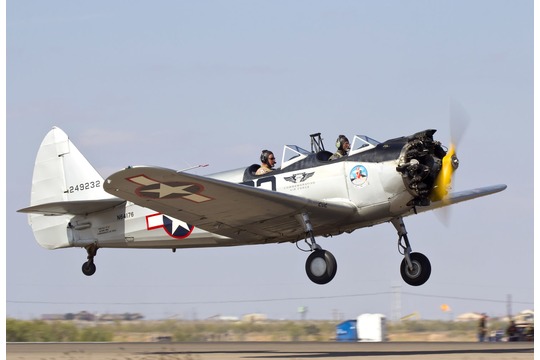PT-23 Miss Mickey Jayhawk Wing

Description:
Base:
Wichita, KS
Website:

| PT-23 Specs | |
|---|---|
| Role | |
| Manufacturer | |
| Length | |
| Height | |
| Wingspan | |
| Range | |
Acquired in 1990, this aircraft was completely disassembled. It had a Continental 220 engine with no prop. The center section had been removed from the fuselage. There were no instruments in the plane. Water damage, weather warping and stampeding cattle added to the challenge of restoration. As you can see from the photo, the PT-23 has come a long way. The PT-23 has been up and flying since July of 1999 after a 6 year restoration. Her maiden flight was on July 11 1999.
This Fairchild PT-23 was used by the United States Army Air Corps as a primary trainer during World War II. The Air Corps pilots were trained in three stages: Primary, Basic and Advanced, before they were sent to operational units to fly the combat aircraft. The pilots began their training in the simple primary aircraft such as our PT-23. The Air Corps began purchasing PT-19 aircraft from the Fairchild Company of Hagerstown, MD. in 1939. As World War II progressed, the Army Air Corps needed many training aircraft to supply all of its new training bases. Five different companies, Fairchild, Aeronca, Howard, St. Louis Aircraft Corp. and Fleet Aircraft, Ltd. of Canada, built the PT-19 series aircraft. A Ranger 6-cylinder in-line engine of 175 horsepower powered the PT-19 series aircraft. Because of the large number of aircraft required and a shortage of engines, Fairchild developed the PT-23 aircraft power by the Continental W-670 220 horsepower radial engine. The PT-23 airframe is identical to the PT-19B aircraft from the engine firewall aft. The only difference in the two aircraft is the engine installation. A further development in the PT-19 was the PT-26. The PT-26 had a 200 horsepower Ranger engine with an enclosed canopy and heater for training in Canada.
Our PT-23 was manufactured on August 15, 1943. This aircraft was used to train Air Corps pilots at the flight school at Fletcher Field, Clarksdale, MS. It is painted in the paint scheme used by the Air Corps at the time of its manufacture. The red outline of the national insignia was only used for a short period of time because it was learned that U.S. troops would shoot at any aircraft with red in the national insignia. The number 202 on the side of the aircraft is the field number of the aircraft used by the training field. The aircraft on display belongs to the Commemorative Air Force, Air Heritage Museum. The aircraft was restored and is operated by Jayhawk Wing of the Commemorative Air Force in Wichita, KS.

